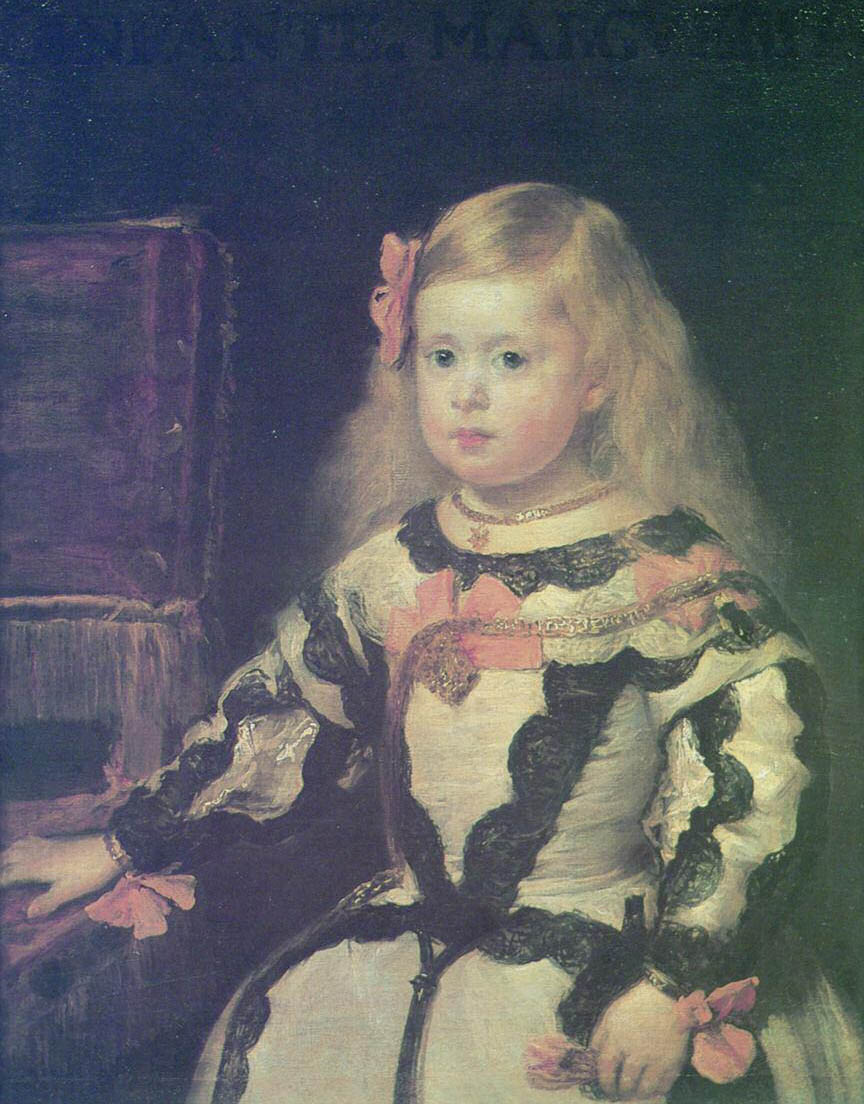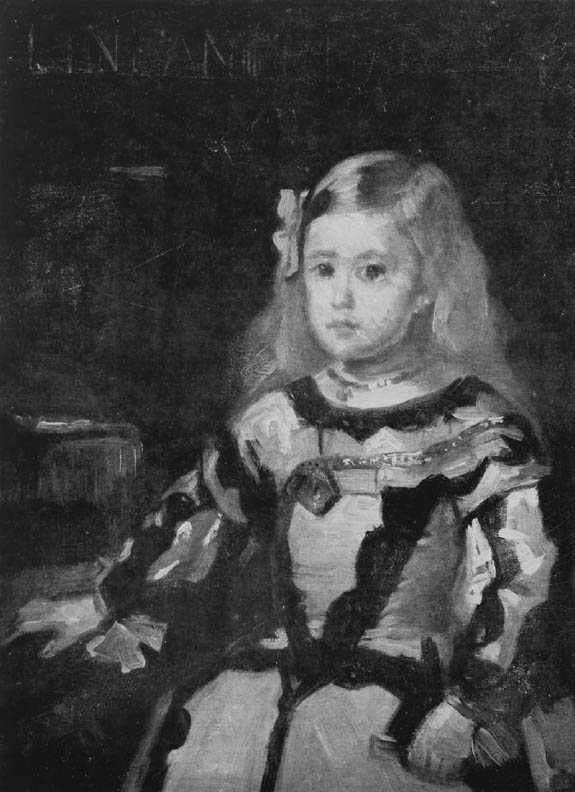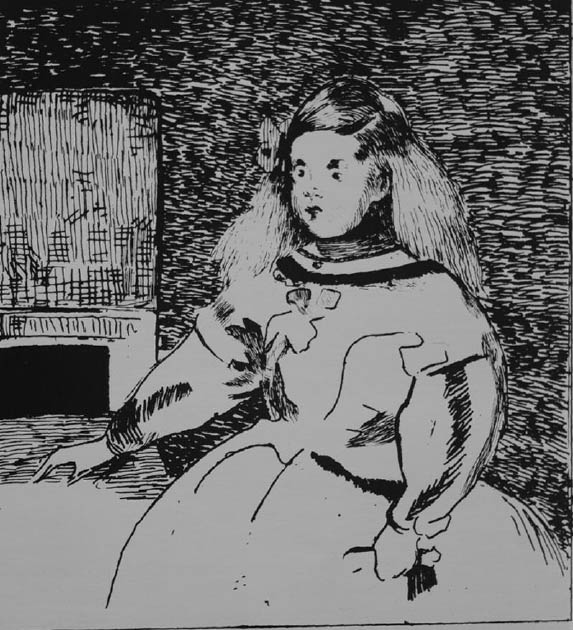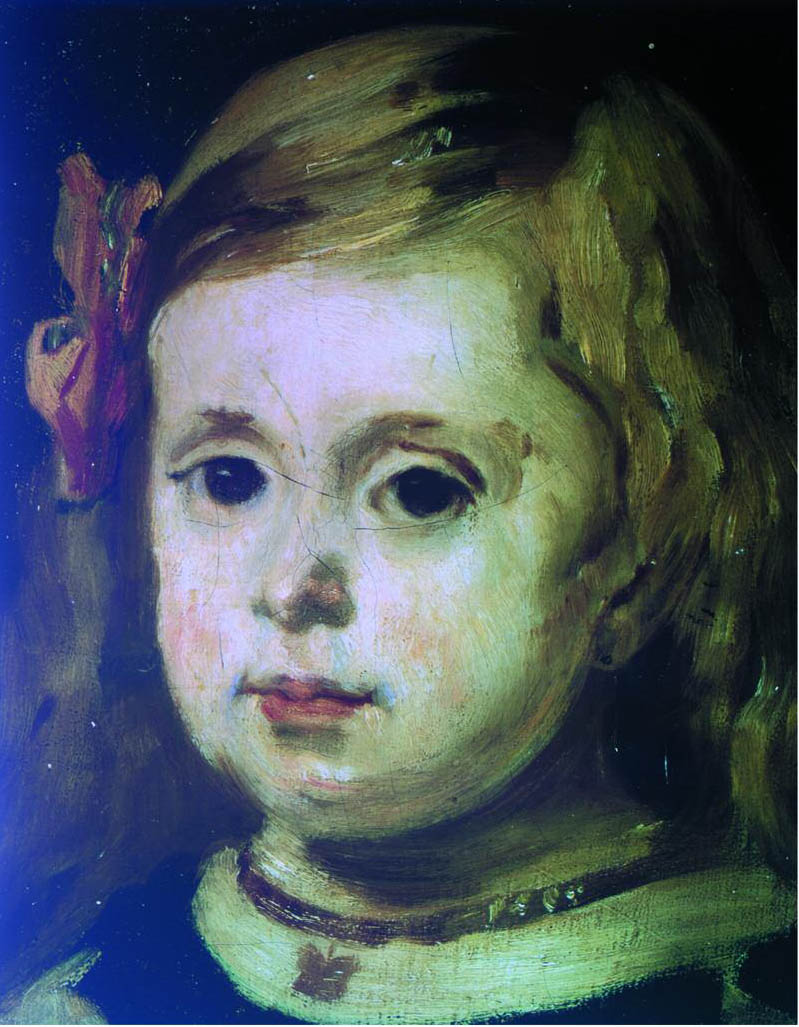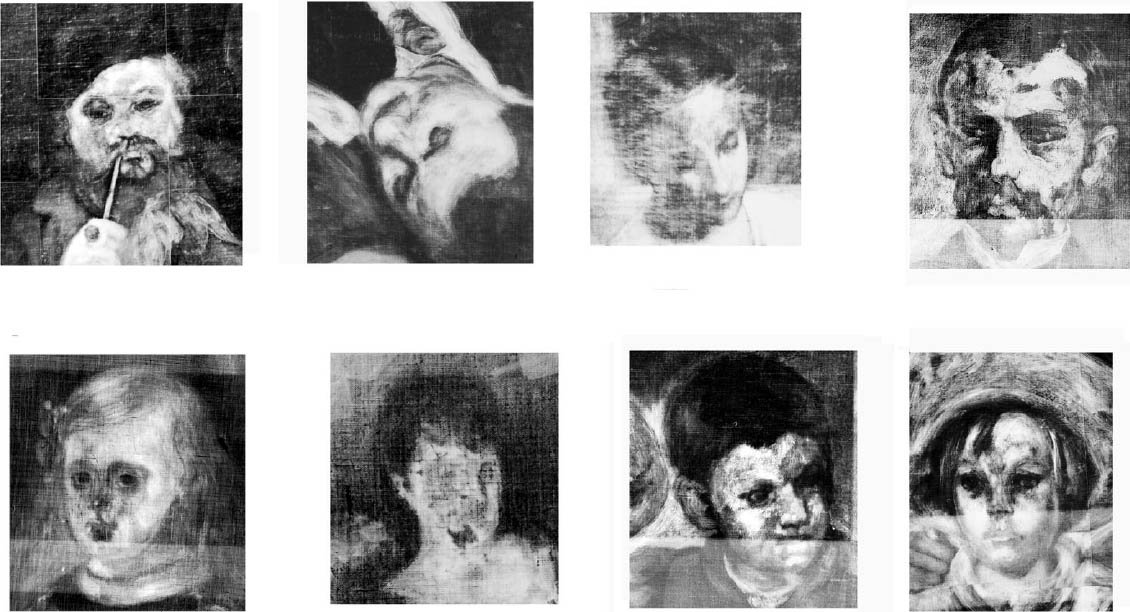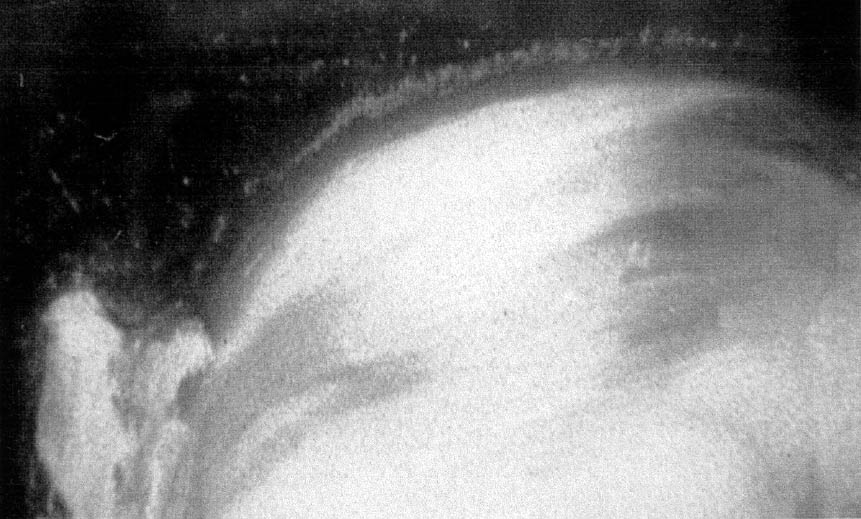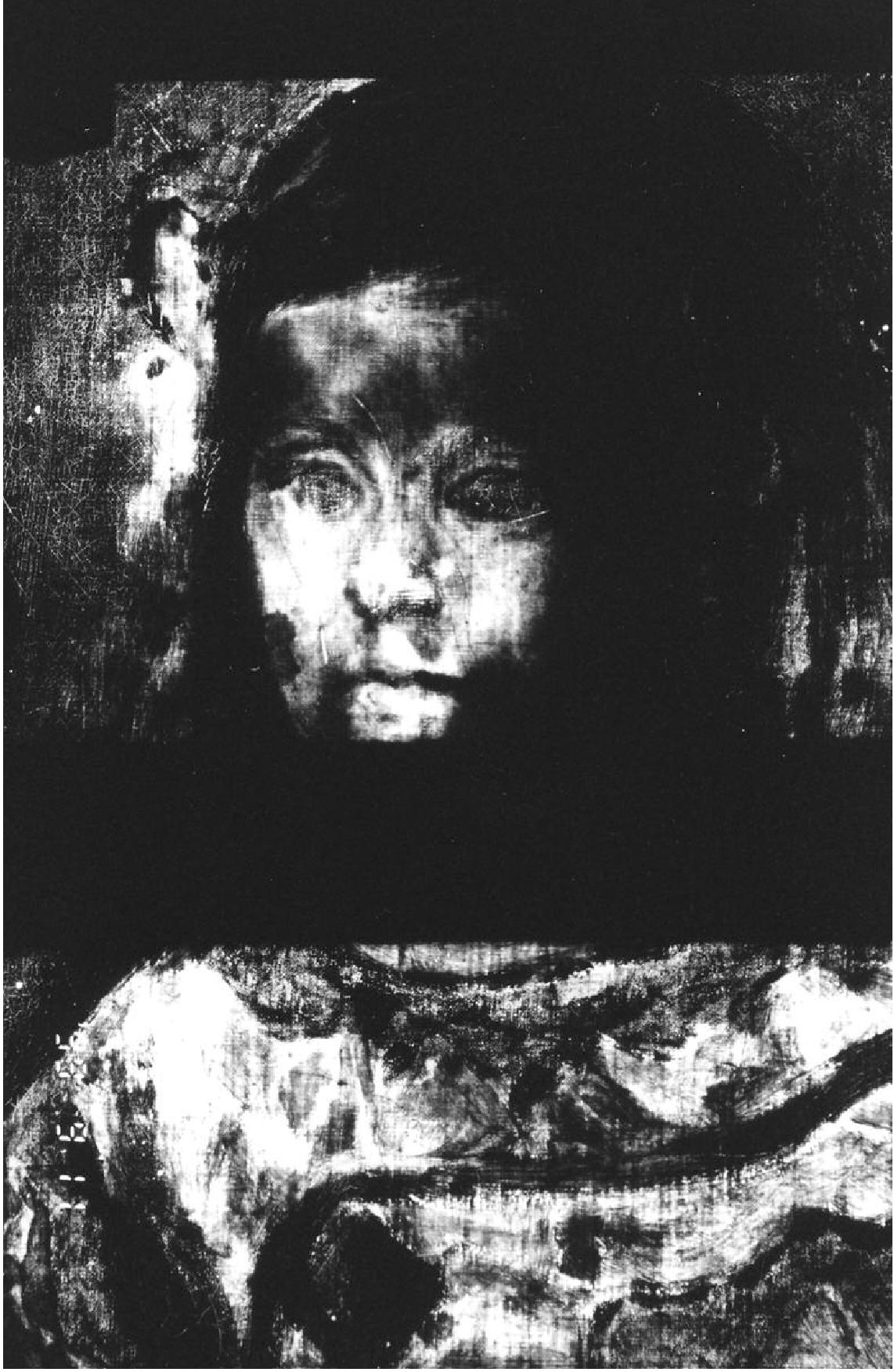MANET'S LOST INFANTAALBERT BOIME, & ALEXANDER KOSSOLAPOV
ABSTRACT—The scientific examination of the privately owned painting (fragment/copy after Vel�zquez's Infanta Maria Margarita from the Louvre collection) has been completed. Based on documented historical evidence, stylistic and chemical analysis of paints, and individual technical features revealed by x-ray radiography and infrared photography (IR), the painting has been attributed to the French painter �douard Manet and dated from the beginning of the 1860s. TITRE—L'Infante perdue de Manet. R�SUM�— L'examen scientifique d'une peinture d'une collection particuli�re a �t� effectu�. Il s'agit d'un fragment/copie de l'oeuvre de V�lasquez intitul�e l'Infante Maria Margarita dans la collection du Louvre. � l'aide de documents historiques, d'analyses stylistiques et chimiques de la peinture, et des caract�ristiques techniques r�v�l�es par les rayons X et la photographie � l'infra-rouge, la peinture a �t� attribu�e au peintre fran�ais �douard Manet et dat�e du d�but des ann�es 1860. TITULO—La infanta perdida de Manet. RESUMEN—Se ha completado el examen cient�fico del cuadro perteneciente a un coleccionista privado (fragmento/copia de Infanta Mar�a Margarita de Vel�squez de la colecci�n privada del Louvre). Sobre la base de evidencia hist�rica documentada, del an�lisis qu�mico y estil�stico de la pintura y los rasgos t�cnicos individuales revelados por radiograf�as (rayosX) y fotograf�as infrarrojas (IR), el cuadro ha sido atribuido al pintor franc�s �douard Manet y fechado en el comienzo de los a�os 1860. T�TULO—A Infanta perdida de Manet. RESUMO—O exame cient�fico da pintura de propriedade particular (fragmento/c�pia da obra de Vel�squez Infanta Maria Margarita, da cole��o do Museu do Louvre) foi conclu�do. Com base nas evid�ncias hist�ricas documentadas, na an�lise estil�stica e qu�mica da pintura e nas caracter�sticas t�cnicas individuais reveladas atrav�s de radiografia com raio-X e fotografia infra-vermelha (IR), a tela foi atribu�da ao pintor franc�s �douard Manet e datada do in�cio dos anos 1860. 1 INTRODUCTIONThe subject of this study is an oil painting, 46.0 � 38.1 cm (fig. 1, see page 442), a fragmentary and unsigned copy of Vel�zquez's familiar Infanta Maria Margarita (fig. 2, see page 442), which has been widely admired since its arrival in the Louvre in 1816. The provenance of this painting is obscure prior to 1967, when an American lawyer briefly working in Amsterdam bought it and three other paintings from a small basement gallery on the Rozengracht. The owner of the gallery initially identified the Infanta painting as a Diego Vel�zquez (1599–1660) in the “certificate” given to its purchaser at the time. He claimed to have discovered it years ago in Paris with its background “fully painted over” (Brainerd 1988, 73). He subsequently removed the overpainting.
In 1968–70 various professionals to whom this Infanta was shown unanimously recognized it as a copy after Vel�zquez, dating to approximately 1850–70. The chief conservator of the Art Institute of Chicago, Alfred Jakstas, for example (Brainerd 1988), concluded from a lengthy examination, with no techniques other than x-rays, binocular microscope, and visual analysis, that it could be dated unequivocally to “third quarter, 19th century.” Another conservation report, dated May 1970, found it was “probably painted in 19th century” and otherwise described its condition as follows:
It may be concluded from the conservators' reports that the state of preservation of the painting was rather poor and, what is more significant, that the paint stains and unprofessional repairs were well in line with the earlier statement of the owner of the Amsterdam gallery. On the back of the horizontal stretcher's crosspiece the word “Bertram” (or “Bertran”) is handwritten with a brushlike instrument. This inscription can scarcely be taken as an indication of authorship for two main reasons: First, the emission spectrum analysis (by Bernard Hauser of Spectro-Chemical Research Laboratories, Chicago, laboratory no. 23548, of November 20, 1970) shows that the inscription material differs from any black on the painting itself. The latter contains lead, while the former does not. This finding might be taken as a good indication of its not being oil color, but rather a type of ink (Brainerd 1988). Second, there are just two artists bearing the name Bertram(n) who are known in the second half of the nineteenth century: Abel Bertram, a French landscape artist born in 1871 (1871–1954), and Pablo Maria Beltran y Tintore, a lesser-known late-19th-century Spanish artist known mostly for his religious scenes in the Cathedral of Salamanca, who studied under Henri Gervex in Paris and exhibited his works in Madrid in 1892 and whose name was sometimes spelled “Bertan” (Thieme-Becker 1909; Saur 1995). Neither of those artists can reasonably be associated with the present Infanta other than as a prior owner or handler. Persistently rebuffed in his attempt to vindicate the relationship to Vel�zquez by a dating inconsistency that was undeniable, the lawyer displayed the painting to a number of professional persons knowledgeable on French art of the period. Inevitably, such studies turned toward the Spanish Revival period (1845–1865) and to one of its main exponents, �douard Manet (1832–1883). On June 18, 1970, one of the recognized �douard Manet historians in the United States, John Richardson, then with Christie's in New York and having seen the photographs of the Infanta with another Manet expert, Professor George Heard Hamilton, wrote a letter to the owner stating that “after examining at length … the various photographs of your Manet …, we both feel it would be rash to dismiss the possibility of its being an authentic early work” (quoted in Brainerd 1988, 95). Other Manet experts, some of whom Richardson had identified, were then consulted, and in a short time it became apparent that about 1860 Manet had in fact executed a copy of the Infanta that had been lost or thought destroyed long ago. One possible claimant for the lost work advanced by Jacques Mathey had long been challenged for its flaccid qualities and consequently was placed outside contention (fig. 3). While the art historians were uniformly receptive to at least the possibility of the present painting's being attributed to Manet, years passed and interest in it subsided, until 1977, when Anne Coffin Hanson included the painting in her seminal work, Manet and the ModernTradition, identifying it as the product of an unknown artist but nonetheless “probably the best contestant” for the lost Manet (Hanson 1977, 156 and fig. 99). 2 ART HISTORICAL VIEWPerhaps no other modern French painter has been submitted to as much intensive scrutiny as �douard Manet. Every conceivable aspect of his life and work seems to have been exhaustively explored, leaving little fresh ground for either the aspiring scholar or seasoned veteran to cultivate. Yet despite the ardent devotion of scholar and critic to Manet and his work as a pathway to modernity, there remain conspicuous gaps in the record, especially concerning his early efforts to modernize canonical models. It is incontestable that Manet deliberately set out to challenge
Perhaps one of the most vexing lacunae in Manet's oeuvre has been the presumed physical absence of the copy that we know he made of Vel�zquez's notorious Infanta Maria Margarita and for which he registered in the Louvre to copy in the period 1859–1860. (We may immediately dismiss the spurious claim of the notorious forger, Eric Hebborn, that his teacher, W.A. Cuthbertson, painted this copy from Las Meninas in the Prado; in Las Meninas the Infanta faces in the opposite direction and wears a different costume! [Hebborn 1991, 45–47]). Although the painting under discussion was an excellent contender for the missing picture and had been proposed by Andrew Brainerd for several years, its lack of provenance and signature had cast a dubious pall over its origins. The oil study set forward by Brainerd as the lost Manet was first published by Anne Coffin Hanson in 1977 in her pathbreaking Manet and the Modern Tradition, where the copy was considered a likely “contestant” for work long known to have existed but never located and presumed lost or destroyed (Hanson 1977). Although she added that it was impossible in the present state of knowledge to firmly identify the picture and so consigned it to unknown authorship, she argued that of all the copies after the popular image that had surfaced over the years, this was the one example that came closest to approximating the methods and colors as well as the freshness and vivacity of Manet's technique and style. The hesitation of Hanson and others to assign an unequivocal attribution was understandable, given the absence of provenance and signature, two existential conditions the want of which naturally render any work problematic. Since Hanson published the painting, however, the work has been rigorously submitted to state-of-the-art scientific analysis. The results of this scrupulous examination ratify what the heart has known all along, and at long last we can state with a comfortable degree of certainty that the outcome of the application of the latest scientific methods to this picture has eradicated whatever reservations specialists may have felt over the years absent the two conditions noted above. Although art historians and art experts seem to be nervous about relying too heavily on the application of conservation science for authentication, in a case of this sort conservation science should be seen as the inevitable and necessary adjunct to sound connoisseurship. Regrettably, many art experts still mistrust the methods of the scientist, but it is our firm belief that not only is this gulf not unbridgeable, in future this collaboration will be the norm. It has always been a Previously, a number of Manet specialists entertained the possibility of this sketch/copy's being a Manet simply on the basis of surface appearances and the historical record. Indeed, on the basis of internal evidence—style, paint layer, and physical structure— there has never been any solid argument mustered by the critics and historians against a Manet identification in the case of the Infanta, and now that all the scientific data have been assembled and analyzed, the attribution seems to us indisputable. There is no need to rehash the abundant historical data of Manet's profound debt to the Spanish master so amply documented in all the monographs. During his trip to Spain in September 1865, he wrote of his admiration for Vel�zquez in rapturous terms, the mere sight of whose work seemed a fulfillment of his most cherished ideals of painting. We know that he registered to copy at the Louvre on July 1, 1859, and two copies after paintings attributed to Vel�zquez belong to that period: Reunion of the Thirteen Cavaliers, usually dated 1859–1860, and the Infanta Maria Margarita, reportedly executed concurrently with Edgar Degas's (1834–1917) reproduction of the same work in 1859 (Reff 1964; Boggs 1958). Vel�zquez's portrait of the Infanta Maria Margarita has been located in the Salon Carr� of the Louvre Museum in Paris since 1816, and it became an object of great interest during the Second Empire at the height of the Spanish Revival. Manet did not fail to acknowledge this connection with Vel�zquez's portrait in his most provocative Salon display of the period, the Olympia of 1863; he slyly transferred the pink flower from the head of the innocent Infanta to the head of his brazen courtesan to complicate his visual associations with the past and parodic challenge to tradition. Manet's emulation of Vel�zquez has recently been made the centerpiece of a major exhibition, Manet/Vel�zquez: The French Taste for Spanish Painting, organized in 2002 at the Mus�e d'Orsay in Paris and shown at the Metropolitan Museum of Art, March through June 2003. The show featured Vel�zquez and Manet side by side, demonstrating the full measure of the impact of the Spanish master on Manet's developing sensibility. Here the viewer had the opportunity to witness directly that Manet's taste for quizzical visual surprise fully exploited Vel�zquez's paradoxical imagery (Schjeldahl 2002). Manet's paraphrase of the Infanta uses a smaller portion of the actual work in the Louvre, turning what is essentially a three-quarters length of the figure into a portrait bust that iconically centers the object. What is remarkable in both the drawn and painted copies of his early phase is his tendency to reduce the actual torsos of the originals to primarily head and shoulders—typical of his master Thomas Couture's drawing style—and to centralize them (Meller 2002). Manet's Portrait of Roudier (Cabinet des dessins, Mus�e du Louvre, Paris) of 1860, for example, showing head and shoulders only of the sitter, could easily pass for the master's work (Boime 1980). The residual influence of Couture on his disciple is perfectly understandable given Manet's relatively recent departure from the studio where he spent almost six years (1850–56). Couture's recipes, however, left an indelible impression on Manet, who continued this practice throughout most of his career, as seen in a series of quick studies of females in the early 1880s (Rouart and Wildenstein 1975). Some of the most startling examples of this approach are the drawn portraits of Gustave Courbet, Claude Monet, and Edgar Allan Poe, and the etched portrait in profile of Charles Baudelaire (ca. 1862–65), all of which dramatically attest to this tendency (Rouart and Wildenstein 1975, vol. 1, nos. 20, 55). In the case of the Infanta, Manet's skillful cropping adapted an off-center figure to his favorite centering mode. Andrew Brainerd has analyzed this tendency to compositional centrality and symmetry in Manet's early portraiture and copying practice in what he describes as the “Manet Matrix” (Brainerd 1988, 41). Although in both his watercolor (fig. 4) Michael Wilson first called attention to the singular process of scraping in Manet's methods, and since the publication of his study, other scholars have noted this propensity of the artist for scraping and rescraping down to the ground (Wilson 1983; Bareau 1986). The oil copy of the Infanta is no exception, and transmitted light photography reveals this salient characteristic of Manet's method in several places. These material traits substantiate the chemical evidence as analyzed by McCrone (Brainerd 1988), whose findings on the pigments in two established early Manet paintings—The Spanish Ballet of 1862 (Phillips Collection, Washington, D.C.) and Woman Pouring Water (Ordrupgaard Collection, Copenhagen) of ca. 1858–60—demonstrated unique optical and chemical properties common to all three and verified that the lead white of the two control samples and that of the Infanta probably originated from the same production lot. This finding means that Manet and the painter of the Infanta used the same pigments from the same supplier or suppliers in approximately the same time period. McCrone estimated the probability of coincidence in trace element concentration at one chance per billion. According to McCrone, the lead white in the The Spanish Ballet and the Infanta could not “be more similar if they had been squeezed from the same tube of paint” (Brainerd 1988, 174). McCrone further found that the agreement of pigment composition in all three examples provides strong support in favor of dating the Infanta near the middle of the 19th century. Finally, the scrupulous x-ray radiography and special photographic analysis, detailed below, further confirm the validity of McCrone's findings (Brainerd 1988) in revealing aspects of methods—preparatory painted contours,
3 NONDESTRUCTIVE TECHNICAL EXAMINATIONIt is worth emphasizing from the very beginning that as soon as the painting was dated and located in Paris by McCrone's report, the field of contenders for authorship of the work was drastically reduced. Although sketch/copies were standard studio practice at the time, the example under consideration still displays singular traits of execution. There were only a handful of artists who, by 1860–62, had developed that “advanced” manner in which the Infanta was executed, and even mere surface observation reveals the color scheme of the Infanta to be an exact match with Manet's contemporaneous palette. We will not proceed, however, along this line of reasoning, but confine ourselves to a purely technical comparison of Manet's production techniques and style (as established both by our own scientific examination of his paintings created around 1860 and by the existing literature, including in particular Michael Wilson's landmark study of the technical methods and procedures of the artist who painted this Infanta [Wilson 1983]). 1. The artist's original outline sketch was done on the white ground of the canvas, painted in some darker color with scarcely any lead white, and appearing as dark fragments (e.g., the hair, eyes, mouth, etc. also look pitchy on the x-ray radiographs). The unfinished portrait of George Moore au Caf� (ca. 1878, Metropolitan Museum of Art, New York) presents such sketched outlines made in this kind of paint: “the lines of the head are brown, the coat and hat are blue-black” (Wilson 1983, 8). Manet's sketching process, however, is revealed neither on his finished paintings by x-rays, as the sketch outlines do not contain enough lead white, nor by infrared photography, as the material used for sketching is deficient in carbon black. On the Infanta, however, the presence of preparatory sketching may be traced on an enlarged photograph of the face (fig. 6, seepage 442) in those areas not built up with pigment during the subsequent modeling. Such areas may be seen, for example, in her upper lip below the left nostril and in the corners of her mouth. These minuscule areas, of course, do not provide us enough information on the sketching method itself but are indicative of its practice.
2. On the finished sketch an underpainting (i.e., the lay-in of three-dimensional objects) begins in darker colors containing less lead white and ends with an almost pure white on the brightest parts. The modeling brushstrokes can be straight or curvy, short or elongated, as they follow the anatomically convex and concave parts of the face. This same manner of underpainting is clearly seen in the Infanta (see fig. 6, page 442), where the darker underpainting shows up in several areas. A comparison of the brushstrokes of the Infanta with those of two other Manet paintings (the boy's face in The Old Musician [ca. 1862, National Gallery of Art] and the forehead of The Dead Toreador [ca. 1862, National Gallery of Art]), discloses brushstrokes of the same type definitely present in all (fig. 7) that verify Manet's “handwriting” on the Infanta. 3. Manet typically applied his paint in a viscous, semidry impasto. The traces of the brush in the hair are usually seen in longer lead-white strokes, while the short ones generously used on smaller light spots/areas are less clearly resolved. These shorter strokes, densely set down, explain why many light regions on radiographs have jagged, torn edges. The light, elevated regions are modeled extremely roughly, almost sculpted rather than painted. Visually such areas, typical for Manet, may be easily traced on figure 6 in the Infanta's left cheek, under her lower lip, on the left part of her chin, under her right eye, and so on. 4. The very idea of following the natural light distribution was alien to the artist. Manet, in principle, did not care about the smooth transition of light to shadow; the thick, bright-white brushstrokes are abruptly juxtaposed with the darker parts as if he ignores the very existence of intermediate halftones, which do not figure in his palette at all (Boime 1971; Wilson 1983). As a result of this technique, the boundary between dark (hair, background) and light
In our investigation we carefully studied the majority of existing x-ray radiographs of the early Manet paintings. In this article, however, we chose for technical comparison several representative examples taken from the paintings dating ca. 1862 (fig. 8): The Old Musician (National Gallery, Washington), The Dead Toreador (National Gallery), La Femme � la Cr�che (Ordrupgaard Collection, Copenhagen), The Spanish Ballet (Phillips Collection), Le Bon Bock, (Philadelphia Museum of Art), Portrait of a Man (Rijksmuseum, Kr�ller-M�ller, Otterlo, Holland). The radiograph of a single Manet copy was available to us, the Self-Portrait of Tintoretto (1854, Mus�e des Beaux Arts, Dijon), a painting crucial for our purpose, but unfortunately we have not received permission to reproduce it. We have included the radiograph of the Infanta's face in the series to show a comparison that to us is self-evident: the Infanta is wearing the same sort of “mask” that everybody else wears in the Manet paintings illustrated. What is especially interesting in this example is that the Infanta's mask is formed by the borderline between her forehead and her hair, despite her hair's not being black but of a lighter color. This feature indicates that the forehead was joined to the black/darker hair during the underpainting stage, while in the finishing stage the hairdo was impastoed in light. In other words, it indicates that the artist followed a manner quite identical to that shown in the other Manet paintings pictured. Significantly, we may also look at the much later (1879) painting of Mlle. Isabelle Lemonnier to demonstrate that Manet did not abandon his “masking” habit for many years following the period under discussion. 5. Probably the most important, patently observable characteristic of Manet's alla prima painting in thick impasto (this technique implies that the volume and coloring were sought simultaneously by the artist) was his strange need to scrape away what he saw as unnecessary paint in order to reveal the more appropriate darker color beneath it. Michael Wilson, who follows, in his turn, the critics Th�odore Duret and George Moore, has ably noted this peculiar feature:“As he applied washes of color to his painted drawing, Manet would continuously revise the contours of his image. Where the paint was thickly laid on he would often scrape it away to allow the ground to show through. … When he was dissatisfied he would scrape away and repaint over and over
In line with this process, we would be inclined to add one related observation, that the overwhelming majority of Manet's works, excepting his copies, reveal on x-ray radiographs total or local compositional changes. Even on his copies, however, as we have seen, Manet at least revised the contours. To proceed along this important line of inquiry, we must briefly comment on certain technical aspects of this scraping process. The result of the scraping of white lead—rich paint on the contours may not be seen well on x-ray radiographs if the scraping did not produce noticeable defects in the lead-rich ground of the painting. What we may be able to see on the radiographs are just a few more jagged edges on the borders between dark and light regions, the effect of which can be well disguised by the technical feature described above (3). The transmitted light photographs (TLPH) and/or reflected infrared photographs, however, can indeed reveal the scraping rather well in cases where the underpainting done with a darker paint on a white background has been scraped away. As few specialists are familiar in practice with these techniques, it may be helpful to explain very briefly the difference between x-ray radiographs and TLPH. For x-ray, the main absorbing pigment in paintings is lead white. As a result, what we see on a radiograph is the lead-white presence, or its distribution, in the painting. For TLPH, the main absorbing paints are those that contain carbon black (burnt bone, charcoal, or soot). When TLPH is made in the infrared region (at wavelength greater than 1.6–1.8 �m), it reveals predominantly the presence of carbon black; when it is made in visual light, it reveals the distribution of all darker, light-absorbing pigments. Lead white, for example, does not absorb light well; its “hiding power” is based on the effective scattering Reflected infrared photographs work, in principle, similarly to common reflected light photography, except that in the infrared spectrum the coefficients of reflection/absorption for artistic pigments differ very much from the corresponding coefficients in the visual range. In particular, in the near infrared, absorption of a majority of pigments is negligible, unlike the visual region (to which main absorption bands of such pigments belong, providing their corresponding colors), and the reflected infrared photography practically does not disclose absorption at all for all pigments with just one exception— carbon black—the pigment for which absorption stays high, almost the same as it is in the visual range. As for the artists' pigments' reflection/scattering, it falls approximately linearly with the increase of the wavelength, and as their absorption stays low, paint layers become more transparent (less reflective) the longer the infrared wavelength chosen for photography. The carbon black–based pigments, though, practically do not change their very high light absorption in the near infrared, and consequently their level of reflectivity remains low. Due to such effects, reflected infrared photographs can help to trace the distribution of carbon black (or pigments containing carbon black) on a painting, revealing, by the way, even the carbon black underpainting or underdrawing hidden under the upper paint layers. Thus, on the reflected infrared photographs, free carbon—containing pigments (visually looking dark/black) are rendered black as they would be in the common visual range photographs, but with much higher contrast due to very small absorption of all other types of pigments looking white (nonabsorbing). If we bear in mind that Manet consistently used white/light grounds on his paintings and that his individual manner included the scraping of his own paint even down into the ground (i.e., at times he scraped away the darker, carbon black underpainting as well), there are excellent opportunities to view the scraping both in TLPH and in reflected infrared. In TLPH the scrapings may look like white lines with jagged contours on the darker background, as the light passing through such scraping is less absorbed compared with the neighboring, nonscraped background. In the infrared the scrapings also look white because the well-reflecting ground is “seen” through the scrapings. In both cases, scraped lines may be situated along the borders of light and shadow zones, where the contours allegedly have been “revised.” As we have thus established certain specific technological criteria for the revealing of scraping, we may now apply them to the Infanta. In figure 9, taken in reflected infrared, the scraping (the broad, lighter-looking scratch with jagged edges) can be definitely traced. The paint was scraped down to the ground of
At the same time, it is necessary to discuss certain differences that the Infanta presents on the radiographs in the comparative series shown in figure 8. The difference is that the painting on the Infanta's face is somehow less full-bodied, the lead-white layer thinner and less “sculptured” than in the other examples. For this reason one cannot clearly see the modeling brushstrokes here, and, as a result, the face looks less spotty, painted less “aggressively” than the other faces on the x-ray radiographs. Significant compositional changes are absent as well. To be scrupulous, we must note that the modeling is performed with a thinner brush than was used, for example, on The Old Musician. We believe that such differences may be explained when we recollect that the painting under examination is indeed a copy, and that the copying process may, by definition,
4 CONCLUSIONSWe introduced the reader to a painting whose artist used both the same colors and combinations of colors, even paints taken from the same factory stock, as those consistently used by Manet ca. 1860. It is a painting that visibly conforms to the large variety of criteria broadly known to characterize the working techniques and cultural affinities of this artist, down to the strange peculiarities of his individual manner. The historical record documents Manet's execution of an oil copy of the Vel�zquez Infanta during this period. Have we then succeeded in establishing the authenticity of the painting? It seems impossible to us to ascribe to coincidence this variety of astonishing congruities. The scientific examination described in this study reports findings objectively arrived at with great caution. We believe it adds confirmation to the convincing factual aggregate of textual material already known about this painting. Our answer to that question of authenticity is consequently, yes, this is the work of �douard Manet, well beyond any reasonable doubt. ACKNOWLEDGEMENTSThe authors express their deep gratitude to colleagues who supplied or made available the photograph and x-ray documents used in this study, or who spent their time in very helpful discussions. In particular we owe special acknowledgment to Ann Hoeningswald and Philip Conisbee (National Gallery of Art, Washington), Henrik Bjerre (Dansk Museum), Christopher Riopelle (National Gallery, London), Mark Tucker and Beth Price (Philadelphia Museum of Art), Albert Kostenevitch, Alexander Babin, A. Sizov, Lilia Viazmenskaia (Hermitage Museum, St. Petersburg), and Jean-Pierre Mohen and R�gis Lapassin (Center for Research and Conservation of French Museums). We appreciate as well the assistance and support of Andrew Brainerd, Esq., Dr. Walter McCrone, and Dr. Leonard Reiffel. It has been through the kind and effective help of all these persons and institutions that this work has been accomplished. REFERENCESBareau, J. W.1986. The hidden face of Manet: An investigation of the artist's working processes. London: Burlington Magazine. BoggsJ. S.1958. Degas notebooks at the Biblioth�que Nationale II: Group B (1858–1861). Burlington Magazine100(June):196–205 Boime, A.1971. The Academy and French painting in the nineteenth century. London: Phaidon Press. Boime, A.1980. Thomas Couture and the eclectic vision. New Haven and London: Yale University Press. Brainerd, A.1988. The Infanta adventure and the lost Manet. Long Beach, Michigan City, Indiana: Reichl Press. Fried, M.1996. Manet's modernism. Chicago: University of Chicago Press. Hanson, A.1977. Manet and the modern tradition. New Haven: Yale University Press. Hebborn, E.1991. Drawn to trouble: The forging of an artist. Frome, England, and London: Mainstream Publishing Projects. Meller, P.2002. Manet in Italy. Burlington Magazine144(February):68–110 Reff, T.1964. Copyists in the Louvre. Art Bulletin46(December):552–59
Rouart, D., and D. Wildenstein 1975. Edouard Manet: Catalogue raisonn�. Lausanne and Paris: La Biblioth�que des Arts. Saur, K. G.1995. Allgemeines K�nstler – Lexikon, vol. 10. Munich-Leipzig: K. G. Saur. 141. Schjeldahl, P.2002. The Spanish lesson: Manet's gift from Vel�zquez. New Yorker, November 18:102–3 Manet/Vel�zquez: The French taste for Spanish painting, ed.G.Tinterow and G.Lacambre. New York: Metropolitan Museum of Art; New Haven: Yale University Press, 2003 Thieme-Becker. 1909. Allgemeines Lexikon der bildenden K�nstler, vol. 3. Leipzig: E. A. Seemann. 512–13. Wilson, M.1983. Manet at work. London: National Gallery. FURTHER READINGMatheyJ. 1963. Graphisme de Manet. Vol. 2, Peintures r�apparues. Paris: F. De Nobele. Moreau-N�laton, E.1926. Manet racont� par lui-m�me. Paris: H. Laurens. Reff, T.1976. Manet: Olympia. New York: Viking Press. Sandblad, N.1954. Manet: Three studies in artistic conception. Lund, Sweden: C. W. K. Gleerup. AUTHOR INFORMATIONALBERT BOIME earned his Ph.D. in art history from Columbia University in 1968. He specializes in the study of modern art and has made notable contributions to the understanding of art instruction in the 19th century. He is currently working on a multivolume Social History of Modern Art, the first two volumes of which have been published by University of Chicago Press. ALEXANDER J. KOSSOLAPOV earned his M.S. in physics at Leningrad University, Russia, in 1970, and his Ph.D. in physics/engineering in 1980. In 1972–90 he was the head of the Laboratory for Scientific Examination of Works of Art in the Hermitage Museum, Leningrad. In 1990 he was senior research fellow in the Getty Conservation Institute, and in 1991–95 special Mellon fellow/senior research fellow/scientist at the Los Angeles County Museum of Art Conservation Center. In 1998–99, he held a position as senior fellow at the Center for Advanced Study in the Visual Arts (CASVA), National Gallery of Art, Washington, D.C. Since 1996 he has held the principal scientific museum position in Russia, as head of the scientific department of the State Hermitage Museum.
 Section Index Section Index |

